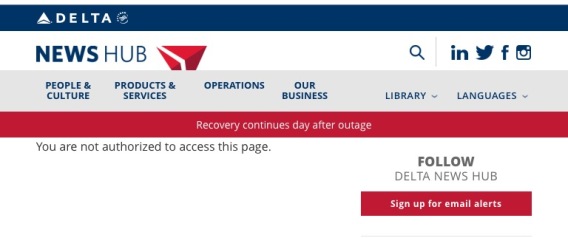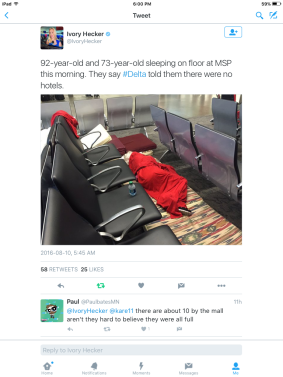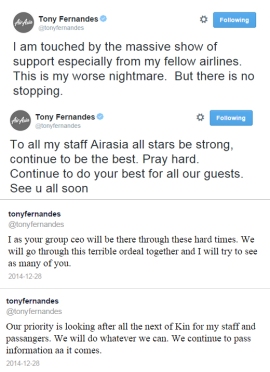On August 8, 2016 Delta airlines experienced a system outage. It resulted in several hundred flights cancelled on that day and thousands delayed worldwide.
I first heard about the outage at 7 am MST when my son phoned me to tell me about it. He and his wife were travelling on August 8, for their long awaited honeymoon. He said he heard that Delta flights were affected and people should check their reservations and flight status before heading out to the airport. When he looked at his reservation online, there were no indications of any problems with any of the flights. He put in a call to Delta and the automated message told him that hold times were anywhere between 4 and 4.5 hours long. He knew that my higher elite status might yield a quicker call back time so he asked that I put in a call. When I called Delta the wait time was an hour and a half to one hour and fifty five minutes long. I input my phone number and waited.
While I was waiting for the callback, I looked at Delta’s twitter feed to see what updated information I might find. It was already 10:30 eastern time and the last tweet from Delta News Hub was almost two hours earlier at 8:40.

I checked the reservation on delta.com and all information showed that flights were still operating on time. Actually, at that point, all flights departing Charlotte NC airport were operating on time according to the Delta website. It was only when I went to look at the Charlotte airport website that I saw how many departing Delta flights were either cancelled or delayed. My son’s flight was scheduled to leave at 3:30 pm for Atlanta to connect with an international flight to Amsterdam. I knew that at this point that they would never make the international connection if they waited for their scheduled flight and only showed up at the airport in the afternoon. I told them to get to the airport as soon as possible and be ready to board any flight that was actually moving.
An hour and thirty seven minutes later I received the call back from Delta. I asked them what flights were still operating from Charlotte to Atlanta and they moved the reservation to flight #2251 that was scheduled to depart at 11:55 am and was now delayed until 2:12 pm. Many of the earlier departing flights had been cancelled. When they got to the airport at least 200 people were in line for agents to deal with their travel issues. The agent informed my son that there was one more flight that was scheduled to leave Charlotte, flight #2609 that was scheduled to depart at 8:44 that morning was now supposed to fly at 2:00 pm and they got boarding passes for that one. They boarded the aircraft just before 3 pm. The aircraft backed away from the gate and sat on the tarmac for 45 minutes. The pilot was great in informing passengers of the delay but eventually pulled back to the gate because Atlanta issued a ground stop, not once but twice since they were sitting on the plane. Eventually that plane took off at 5:23 pm and got into Atlanta at 6:06 pm.
For several hours if passengers checked their flight status on the delta.com website or the delta app, neither showed that the flights were cancelled. Cancellations showed up if you searched the arrival and departure information of certain airports. Some flight tracking sites like www.flightaware.com and www.flightstats.com showed updated departure times (some with 6 hour departure delays) hours before the Delta website did.
Delta’s Unhelpful Cancellation Announcements
At 8:00 a.m. Delta News Hub started posting that 300 flights were cancelled and by 1:30 the number was up to 451. It’s great to give this update but let’s help people out a little by letting them know quickly and easily what flights were cancelled. As the day wore on, more and more flights were cancelled and travelers stranded without much help. Lines at the airports were long, waiting for call backs was endless and the Delta website did not give accurate information. That’s a problem.
Delta had every opportunity to use their Delta News Hub website to have a running list of cancelled flights making it easier for customers to get instant information. This was a huge missed opportunity. Actually when you look at the News Hub site, it looks like it is tailored for shareholders of the company and not the passenger. It is simply an old fashioned crank out the news platform…not designed to be interactive or helpful.
Delta.com
Delta did not use their website to their advantage at all. Where was the alert or warning right on the home page of the website? Nowhere did Delta.com advise the passengers of the outage and its effect on flights.
Social Media can help or hinder
One of the greatest tools any corporation has in times of crisis is social media. It’s a fast way to get the message out to thousands of customers in real time. It is the go to tool that customers use to get up to the minute information.
Here’s one example of the blunders we found on Delta News Hub

Great! until you clicked on the link and found this:

What? Not authorized?
Social Media Blunder Rule #1
Never deny access to information you have advertised on public posts/tweets.
This type of blunder on a high crisis travel day just stresses passengers out even more. Social media could have been used to an advantage but wasn’t. Who was tweeting, posting and commenting for Delta Airlines?
Who’s in charge of the message?
In June of this year Delta hired Moxie USA (www.moxieusa.com) as their social media agency. Only a few weeks into the relationship and the social media strategy has failed considerably.
“Moxie is a recognized expert in the social space,” said Julieta McCurry, Director, Marketing Communications at Delta. “As we continue to grow, it’s critical that we create meaningful and relevant experiences for our customers across the channels they increasingly rely on the most.”
Kristina Jonathan, EVP of Strategy at Moxie, commented, “Social plays an always-on and central role in Delta’s business — connecting customer service, brand relevance and flight reservations 24/7. We are absolutely thrilled to partner with the Delta team to design and employ sophisticated storytelling across the largest shared spaces on the web.”
So many of these agencies promise the moon but fail on delivery when a crisis presents itself. Why? Because most of them aren’t equipped to handle it. In this case it seems that Delta itself had no clear cut strategy for crisis although they should have. So those people tweeting, posting and commenting on behalf of the company had to wait for some sort of corporate approval before each tweet or post was sent. Well prepared corporations plan for crisis and carry out drills to be prepared for the real event.
Another problem is that those who are handling the crisis on the inside really have no idea what the customer is experiencing on the outside. The lack of returned calls, the 200 person long line ups at the airport, no idea when things will get back to normal and the sense of loss knowing that they will miss important events like a parents 50th wedding anniversary or honeymoons unnerve people. These stories are all over twitter and Facebook.
What are you doing to make this easier for your customer?
That’s the bottom line in any messaging during a crisis. No one wants to see a corporate video that looks it is made to appease the shareholders.They don’t want to see posts that offer no solutions and they don’t want to see information links that tell a customer they aren’t authorized to view the page. They want to see solutions. Is the website now showing updated and real flight cancellations? Have you put more staff on the phones to try and make the wait time shorter? Tell us. Tell us what you are doing to help us.

“This isn’t who we are”
Delta CEO Ed Bastian was featured in two videos about the outage; the first an apology and update from the operation center and the second, a confusing message stating “this isn’t who we are”.
Social media begs that leadership of organizations show the human touch to communications online today. Take for example the tweets of Air Asia CEO Tony Fernandes after the Air Crash QZ8501

These were personal and created a connection with anyone reading them. There was no question that he cared about everyone affected. It’s the difference between a personal message and a corporate one. It doesn’t seem that Ed Bastian has a twitter account…maybe he should.
Delta stated it wanted to “create meaningful and relevant experiences for our customers across the channels they increasingly rely on the most.” In this case I think they missed their mark.
Before I go
Lastly I do want to acknowledge how amazing Delta airport staff and flight crews were during this crisis. The pressure on the front lines is enormous. Also big thank you needs to go out to staff from United and Frontier Airlines in Charlotte Douglas International Airport who stepped in to help Delta staff with Delta passengers.
By the way 48 hours later and my son still didn’t get a call back from Delta.
Nejolla Korris is a speaker and consults and teaches classes on social media risk and other security topics. If you are interested in Nejolla as a speaker or for more information, visit Nejolla’s website at www.interveritas.com. She is also a very frequent flyer on Delta airlines and usually loves their customer service.



